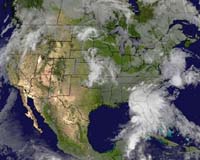 |
Washington DC (SPX) May 02, 2011 Fish and marine species are among the most threatened wildlife on earth, due partly to over exploitation by fishing fleets. Yet there are differences in assessing trends in worldwide fishing stocks which, researchers writing in Conservation Biology argue, stem from inappropriate use of time trends in catches. "Estimates of fishery status based on catches suggest that around 30% of fisheries are collapsed and 70% are overexploited or collapsed," said lead author Dr Trevor Branch from the University of Washington in Seattle. "Our assessment shows that the data are seriously biased, and that instead we should be looking at biomass data." Biomass data from scientific stock assessments indicated a much smaller proportion in these categories (12% collapsed, 26% overexploited or collapsed), and that status trends are stable. Dr Branch's analysis suggests that in most regions fisheries management has led to stabilization, and even recovery, of fished populations. "Species which are targeted by fishing fleets are divided into stocks, a division of species into units based on political boundaries, genetic divergence, and biological characteristics," said Branch. "The depletion of these stocks has important implications for ecosystem biodiversity; however methods of measuring depletion vary greatly." Dr Branch's team considered stocks being "collapsed" or "overexploited" on the basis of catch and biomass data. Collapse is defined as biomass of less than 10% of unfished levels while over exploitation is defined by the governments of the United States and Australia as biomass below 50% of biomass that would produce maximum sustained catches. These reference points are widely used in fisheries management, either as management targets or as limits not to be exceeded. "Our study found the status of stocks worldwide based on catch trends to be almost identical to what would be expected if catches were randomly generated with no trend at all," said Branch, "and that most classifications of collapse on the basis of catch data are not true collapses but are due to taxonomic reclassification, regulatory changes in fisheries, and market changes." Dr Branch's team argue that where available, biomass data can be used to ground truth catch trends, revealing that catch data greatly overestimates the percentage of stocks collapsed and overexploited. Although the team's biomass data was primarily from industrial fisheries in developed countries, the status of these stocks estimated from catch data is similar to the status of stocks in the rest of the world estimated from catch data. "Instead of focusing on what we take out of the oceans (catches), we should be examining the actual state of the ecosystem (biomass data)," concludes Branch. "Catch data produce seriously biased estimates of what is going on in ocean ecosystems, and we need more effort expended on scientific surveys and stock assessments, especially in areas that are currently poorly assessed."
Share This Article With Planet Earth
Related Links - Water News - Science, Technology and Politics
 U.S. land mass is shrinking
U.S. land mass is shrinkingNew York (UPI) Apr 30, 2011 The Census Bureau says the U.S. land mass has been shrinking since 1940. The U.S. land mass was 3,554,608 square miles in 1940; in 1990 it had declined to 3,536,278, The New York Times reported Saturday. However, geographers said most of the difference is a result of improved satellite imagery and other mapping technology that makes it easier to distinguish land from water. ... read more |
|
| The content herein, unless otherwise known to be public domain, are Copyright 1995-2010 - SpaceDaily. AFP and UPI Wire Stories are copyright Agence France-Presse and United Press International. ESA Portal Reports are copyright European Space Agency. All NASA sourced material is public domain. Additional copyrights may apply in whole or part to other bona fide parties. Advertising does not imply endorsement,agreement or approval of any opinions, statements or information provided by SpaceDaily on any Web page published or hosted by SpaceDaily. Privacy Statement |